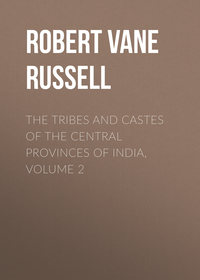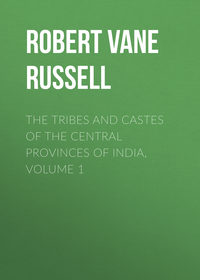 полная версия
полная версияThe Tribes and Castes of the Central Provinces of India, Volume 4
Amarbel is an endless creeper, with long yellow strings like stalks, which infests and destroys trees; it is called amarbel or the immortal, because it has no visible root. Kamalgata is the seed of the lotus; gai ka matha is buttermilk; nagar sowāsan, ‘the happiness of the town,’ is turmeric, because married women whose husbands are alive put turmeric on their foreheads every day; khāj, dād and sehua are itch, ringworm and some kind of rash, perhaps measles; and the verse therefore means:
“Eat amarbel, lotus seeds, chirota, buttermilk and turmeric mixed together, and you will keep off itch, ringworm and measles.” Chirota is good for the itch.
41. Caste-feasts
At the commencement of a marriage or other ceremonial feast the host must wash the feet of all the guests himself. If he does not do this they will be dissatisfied, and, though they will eat at his house, will consider they have not been properly welcomed. He takes a large brass plate and placing the feet of his guest on it, pours water over them and then rubs and dries them; the water is thrown away and fresh water poured out for the next guest unless they should be brothers. Little flat stools about three inches high are provided for the guests, and if there are not enough of them a carpet is spread; or baithkis or sitting-mats plaited from five or six large leaves are set out. These serve as a mark of attention, as it would be discourteous to make a man sit on the ground, and they also prevent the body-cloth from getting wet. The guests sit in the chauk or yard of the house inside, or in the angan or outside yard, either in lines or in a circle; members of the same caste sit with their crossed knees actually touching those of the man on either side of them to emphasise their brotherhood; if a man sat even a few inches apart from his fellows people would say he was out of caste—and this is how a man who is put out of caste actually does sit. Before each guest may be set two plates of leaves and eight donas or leaf-cups. On the plates are heaped rice, cakes of wheat fried in butter, and of husked urad pulse cooked with tilli or sesamum oil, and the pulse of gram and lentils. In the cups will be sugar, ghī, dahi or curded milk, various vegetables, pumpkins, and besin or ground gram cooked with buttermilk. All the male members of the host’s family serve the food and they take it round, heaping and pouring it into each man’s plates or cups until he says enough; and they continue to give further helpings as required. All the food is served at once in the different plates and cups, but owing to the number of guests a considerable time elapses before all are fully served, and the dinner lasts about two hours. The guests eat all the different dishes together with their fingers, taking a little of each according to their fancy. Each man has his lota or vessel of water by him and drinks as he eats. When the meal is finished large brass plates are brought in, one being given to about ten guests, and they wash their hands over these, pouring water on them from their vessels. A fresh carpet is then spread in the yard and the guests sit on it, and betel-leaf and tobacco are distributed. The huqqa is passed round, and chilams and chongis (clay pipe-bowls and leaf-pipes) are provided for those who want them. The women do not appear at the feast but stay inside, sitting in the angan or inner court, which is behind the purda.
42. Hospitality
The people still show great hospitality, and it is the custom of many mālguzārs, at least in Chhattīsgarh, to afford food and a night’s rest to all travellers who may require it. When a Brāhman comes to the village such mālguzārs will give him one or two annas, and to a Pandit or learned man as much as a rupee. Formerly it is said that when any stranger came through the village he was at once offered a cup of milk and told to drink it or throw it away. But this custom has died out in Chhattīsgarh, though one has met with it once or twice in Sambalpur. When District Officers go on tour, well-to-do landowners ask to be allowed to supply free provisions for the whole camp at least for a day, and it is difficult to refuse them gracefully. In Mandla, Banias and mālguzārs in villages near the Nerbudda sometimes undertake to give a pound of grain to every parikramawāsi or pilgrim perambulating the Nerbudda. And as the number of these steadily increases in consequence, they often become impoverished as a result of such indiscriminate charity.
43. Social customs. Tattooing
The Kurmis employ Brāhmans for their ceremonies. They have gurus or spiritual preceptors who may be Brāhmans or Bairāgis; the guru is given from 8 annas to Rs. 5 when he initiates a neophyte, as well as his food and a new white cloth. The guru is occasionally consulted on some religious question, but otherwise he does nothing for his disciple except to pay him an occasional visit, when he is hospitably entertained. The Kurmis of the northern Districts do not as a rule eat meat and also abstain from alcohol, but in Chhattīsgarh they eat the flesh of clean animals and fish, and also of fowls, and drink country liquor. Old men often give up flesh and wine as a mark of piety, when they are known as Bhagat or holy. They will take food cooked with water only from Brāhmans, and that cooked without water from Rājpūts, Banias and Kāyasths as well. Brāhmans and Rājpūts will take water from Kurmis in the northern Districts though not in Chhattīsgarh. Here the Kurmis do not object to eating cooked food which has been carried from the house to the fields. This is called rengai roti, and castes which will eat it are considered inferior to those who always take their food in the chauka or purified place in the house. They say ‘Rām, Rām’ to each other in greeting, and the Raipur Kurmis swear by a dog or a pig. Generally they do not plough on the new or full moon days. Their women are tattooed after marriage with dots on the cheeks, marks of flies on the fingers, scorpions on the arms, and other devices on the legs.
44. Caste penalties
Permanent expulsion from caste is inflicted for a change of religion, taking food or having sexual intercourse with a member of an impure caste, and for eating beef. For killing a man, a cow, a buffalo, an ass, a horse, a squirrel, a cat or a monkey a man must purify himself by bathing in the Ganges at Allahābād or Benāres and giving a feast to the caste. It will be seen that all these are domestic animals except the monkey, who is the god Hanumān. The squirrel is counted as a domestic animal because it is always about the house, and the souls of children are believed to go into squirrels. One household animal, the dog, is omitted, and he appears to be less sacred than the others. For getting maggots in a wound the offender must bathe in a sacred river, such as the Nerbudda or Mahānadi, and give a feast to the caste. For eating or having intercourse with a member of any caste other than the impure ones, or for a liaison within the caste, or for divorcing a wife or marrying a widow, or in the case of a woman for breaking her bangles in a quarrel with her husband, a penalty feast must be given. If a man omits to feast the caste after a death in his family a second feast is imposed, and if he insults the panchāyat he is fined.
45. The cultivating status
The social status of the Kurmi appears to be that of the cultivator. He is above the menial and artisan castes of the village and the impure weaving and labouring castes; he is theoretically equal to the artisan castes of towns, but one or two of these, such as the Sunār or goldsmith and Kasār or brass-worker, have risen in the world owing to the prosperity or importance of their members, and now rank above the Kurmi. The Kurmi’s status appears to be that of the cultivator and member of the village community, but a large proportion of the Kurmis are recruited from the non-Aryan tribes, who have obtained land and been admitted into the caste, and this tends to lower the status of the caste as a whole. In the Punjab Kurmis apparently do not hold land and are employed in grass-cutting, weaving, and tending horses, and are even said to keep pigs.83 Here their status is necessarily very low as they follow the occupations of the impure castes. The reason why the Kurmi as cultivator ranks above the village handicraftsmen may perhaps be that industrial pursuits were despised in early times and left to the impure Sūdras and to the castes of mixed descent; while agriculture and trade were the occupations of the Vaishya. Further, the village artisans and menials were supported before the general use of current coin by contributions of grain from the cultivators and by presents of grain at seed-time and harvest; and among the Hindus it is considered very derogatory to accept a gift, a man who does so being held to admit his social inferiority to the giver. Some exception to this is made in the case of Brāhmans, though even with them the rule partly applies. Of these two reasons for the cultivator’s superiority to the menial and artisan castes the former has to a large extent lost its force. The handicrafts are no longer considered despicable, and, as has been seen, some of the urban tradesmen, as the Sunār and Kasār, now rank above the Kurmi, or are at least equal to him. Perhaps even in ancient times these urban artificers were not despised like the village menials, as their skill was held in high repute. But the latter ground is still in full force and effect in the Central Provinces at least: the village artisans are still paid by contributions from the cultivator and receive presents from him at seed-time and harvest. The remuneration of the village menials, the blacksmith, carpenter, washerman, tanner, barber and waterman is paid at the rate of so much grain per plough of land according to the estimated value of the work done by them for the cultivators during the year. Other village tradesmen, as the potter, oilman and liquor-vendor, are no longer paid in grain, but since the introduction of currency sell their wares for cash; but there seems no reason to doubt that in former times when no money circulated in villages they were remunerated in the same manner. They still all receive presents, consisting of a sowing-basketful of grain at seed-time and one or two sheaves at harvest. The former are known as Bījphuti, or ‘the breaking of the seed,’ and the latter as Khanvār, or ‘that which is left.’ In Bilāspur the Kamias or village menials also receive as much grain as will fill a winnowing-fan when it has been threshed. When the peasant has harvested his grain all come and beg from him. The Dhīmar brings waternut, the Kāchhi or market-gardener some chillies, the Teli oil and tobacco, the Kalār some liquor if he drinks it, the Bania some sugar, and all receive grain in excess of the value of their gifts. The village menials come for their customary dues, and the Brāhman, the Nat or acrobat, the Gosain or religious mendicant, and the Fakīr or Muhammadan beggar solicit alms. On that day the cultivator is like a little king in his fields, and it is said that sometimes a quarter of the crop may go in this way; but the reference must be only to the spring crop and not to the whole holding. In former times grain must have been the principal source of wealth, and this old custom gives us a reason for the status of the cultivator in Hindu society. There is also a saying:
Uttam kheti, madhyam bān,Kanisht chākri, bhīk nidān,or ‘Cultivation is the best calling, trade is respectable, service is menial, and begging is degraded.’
46. Occupation
The Kurmi is the typical cultivator. He loves his land, and to lose it is to break the mainspring of his life. His land gives him a freedom and independence of character which is not found among the English farm-labourers. He is industrious and plodding, and inured to hardship. In some Districts the excellent tilth of the Kurmi’s fields well portrays the result of his persevering labour, which he does not grudge to the land because it is his own. His wife is in no way behind him; the proverb says, “Good is the caste of the Kurmin; with a hoe in her hand she goes to the fields and works with her husband.” The Chandnāhu Kurmi women are said to be more enterprising than the men, keeping them up to their work, and managing the business of the farm as well as the household.
Appendix
List of Exogamous Clans
Sections of the Chandnāhu subcaste:


Sections of the Gabel subcaste:
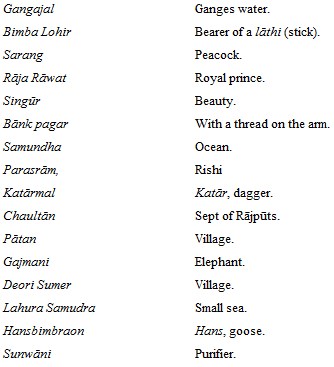
Sections of the Santora subcaste:

Sections of the Tirole subcaste:
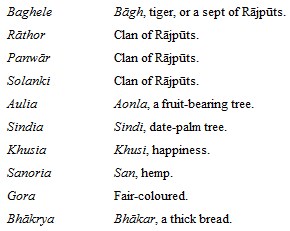
Sections of the Gaur subcaste:
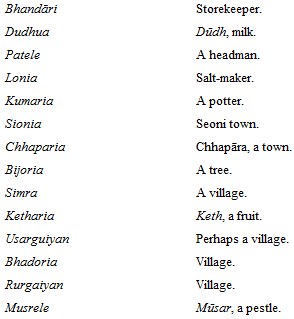
Sections of the Usrete subcaste:
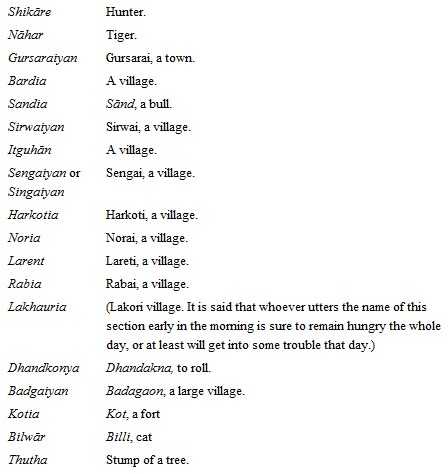
Sections of the Kanaujia subcaste:
• Tidha.—From Tidha, a village. This section is subdivided into (a) Ghureparke (of the cow-dung hill); (b) Dwārparke (of the door); and (c) Jangi (warrior).
• Chamania—From Chamyani (village). This is also subdivided into:
• (a) Gomarkya
• (b) Mathuria (Muttra town).
• Chaudhri (caste headman). This is divided as follows:
• (a) Majhgawān A village.
• (b) Purva thok Eastern group.
• (c) Pashchim thok Western group.
• (d) Bamurya A village.
• Rāwat Title.
• Malha Perhaps sailor or wrestler.
• Chiloliān Chiloli, a village.
• Dhanuiyan Dhanu Kheda, a village.
Lakhera
1. General notice
Lakhera, Laheri.—The small caste whose members make bangles and other articles of lac. About 3000 persons were shown as belonging to the caste in the Central Provinces in 1911, being most numerous in the Jubbulpore, Chhīndwāra and Betūl Districts. From Berār 150 persons were returned, chiefly from Amraoti. The name is derived from the Sanskrit laksha-kara, a worker in lac. The caste are a mixed functional group closely connected with the Kacheras and Patwas; no distinction being recognised between the Patwas and Lakheras in some localities of the Central Provinces. Mr. Baillie gives the following notice of them in the Census Report of the North-Western Provinces (1891): “The accounts given by members of the caste of their origin are very various and sometimes ingenious. One story is that like the Patwas, with whom they are connected, they were originally Kāyasths. According to another account they were made from the dirt washed from Pārvati before her marriage with Siva, being created by the god to make bangles for his wife, and hence called Deobansi. Again, it is stated, they were created by Krishna to make bangles for the Gopis or milkmaids. The most elaborate account is that they were originally Yāduvansi Rājpūts, who assisted the Kurus to make a fort of lac, in which the Pāndavas were to be treacherously burned. For this traitorous conduct they were degraded and compelled eternally to work in lac or glass.”
2. Social customs
The bulk of these artisan and manufacturing castes tell stories showing that their ancestors were Kāyasths and Rājpūts, but no importance can be attached to such legends, which are obviously manufactured by the family priests to minister to the harmless vanity of their clients. To support their claim the Lakheras have divided themselves like the Rājpūts into the Sūrajvansi and Somvansi subcastes or those who belong to the Solar and Lunar races. Other subdivisions are the Mārwāri or those coming from Mārwār in Rājpūtana, and the Tarkhera or makers of the large earrings which low-caste women wear. These consist of a circular piece of wood or fibre, nearly an inch across, which is worked through a large hole in the lobe of the ear. It is often the stalk of the ambāri fibre, and on the outer end is fixed a slab decorated with little pieces of glass. The exogamous sections of the Lakheras are generally named after animals, plants and natural objects, and indicate that the caste is recruited from the lower classes of the population. Their social customs resemble those of the middle and lower Hindustāni castes. Girls are married at an early age when the parents can afford the expense of the ceremony, but no penalty is incurred if the wedding is postponed for want of means. The remarriage of widows and divorce are permitted. They eat flesh, but not fowls or pork, and some of them drink liquor, while others abstain. Rājpūts and Banias will take water from them, but not Brāhmans. In Bombay, however, they are considered to rank above Kunbis.
3. The lac industry
The traditional occupation of the Lakheras is to make and sell bangles and other articles of lac. Lac is regarded with a certain degree of superstitious repugnance by the Hindus because of its red colour, resembling blood. On this account and also because of the sin committed in killing them, no Hindu caste will propagate the lac insect, and the calling is practised only by Gonds, Korkus and other primitive tribes. Even Gonds will often refuse employment in growing lac if they can make their living by cultivation. Various superstitions attach to the propagation of the insects to a fresh tree. This is done in Kunwār (September) and always by men, the insects being carried in a leaf-cup and placed on a branch of an uninfected tree, usually the kusum.84 It is said that the work should be done at night and the man should be naked when he places the insects on the tree. The tree is fenced round and nobody is allowed to touch it, as it is considered that the crop would thus be spoiled. If a woman has lost her husband and has to sow lac, she takes her son in her arms and places the cup containing the insects on his head; on arriving at the tree she manages to apply the insects by means of a stick, not touching the cup with her own hands. All this ritual attaches simply to the infection of the first tree, and afterwards in January or February the insects are propagated on to other trees without ceremony. The juice of onions is dropped on to them to make them healthy. The stick-lac is collected by the Gonds and Korkus and sold to the Lakheras; they clear it of wood as far as possible and then place the incrusted twigs and bark in long cotton bags and heat them before a fire, squeezing out the gum, which is spread out on flat plates so as to congeal into the shape of a pancake. This is again heated and mixed with white clay and forms the material for the bangles. They are coloured with chapra, the pure gum prepared like sealing-wax, which is mixed with vermilion, or arsenic and turmeric for a yellow colour. In some localities at least only the Lakheras and Patwas and no higher caste will sell articles made of lac.

Examples of spangles worn by women on the forehead
4. Lac bangles
The trade in lac bangles has now greatly declined, as they have been supplanted by the more ornamental glass bangles. They are thick and clumsy and five of them will cover a large part of the space between the elbow and the wrist. They may be observed on Banjāra women. Lac bangles are also still used by the Hindus, generally on ceremonial occasions, as at a marriage, when they are presented to and worn by the bride, and during the month of Shrāwan (July), when the Hindus observe a fast on behalf of the growing crops and the women wear bangles of lac. For these customs Mr. Hīra Lāl suggests the explanation that lac bangles were at one time generally worn by the Hindus, while glass ones are a comparatively recent fashion introduced by the Muhammadans. In support of this it may be urged that glass bangles are largely made by the Muhammadan Turkāri or Sīsgar, and also that lac bangles must have been worn prior to glass ones, because if the latter had been known the clumsy and unornamental bracelet made of lac and clay could never have come into existence. The wearing of lac bangles on the above occasions would therefore be explained according to the common usage of adhering on religious and ceremonial occasions to the more ancient methods and accessories, which are sanctified by association and custom. Similarly the Holi pyre is often kindled with fire produced by the friction of wood, and temples are lighted with vegetable instead of mineral oil.
5. Red, a lucky colour
It may be noted, however, that lac bangles are not always worn by the bride at a wedding, the custom being unknown in some localities. Moreover, it appears that glass was known to the Hindus at a period prior to the Muhammadan invasions, though bangles may not have been made from it. Another reason for the use of lac bangles on the occasions noticed is that lac, as already seen, represents blood. Though blood itself is now repugnant to the Hindus, yet red is pre-eminently their lucky colour, being worn at weddings and generally preferred. It is suggested in the Bombay Gazetteer85 that blood was lucky as having been the first food of primitive man, who learnt to suck the blood of animals before he ate their flesh. But it does not seem necessary to go back quite so far as this. The earliest form of sacrifice, as shown by Professor Robertson Smith,86 was that in which the community of kinsmen ate together the flesh of their divine or totem animal god and drank its blood. When the god became separated from the animal and was represented by a stone at the place of worship and the people had ceased to eat raw flesh and drink blood, the blood was poured out over the stone as an offering to the god. This practice still obtains among the lower castes of Hindus and the primitive tribes, the blood of animals offered to Devi and other village deities being allowed to drop on to the stones representing them. But the higher castes of Hindus have abandoned animal sacrifices, and hence cannot make the blood-offering. In place of it they smear the stone with vermilion, which seems obviously a substitute for blood, since it is used to colour the stones representing the deities in exactly the same manner. Even vermilion, however, is not offered to the highest deities of Neo-Hinduism, Siva or Mahādeo and Vishnu, to whom animal sacrifices would be abhorrent. It is offered to Hanumān, whose image is covered with it, and to Devi and Bhairon and to the many local and village deities. In past times animal sacrifices were offered to Bhairon, as they still are to Devi, and though it is not known that they were made to Hanumān, this is highly probable, as he is the god of strength and a mighty warrior. The Mānbhao mendicants, who abhor all forms of bloodshed like the Jains, never pass one of these stones painted with vermilion if they can avoid doing so, and if they are aware that there is one on their road will make a circuit so as not to see it.87 There seems, therefore, every reason to suppose that vermilion is a substitute for blood in offerings and hence probably on other occasions. As the places of the gods were thus always coloured red with blood, red would come to be the divine and therefore the propitious colour among the Hindus and other races.




